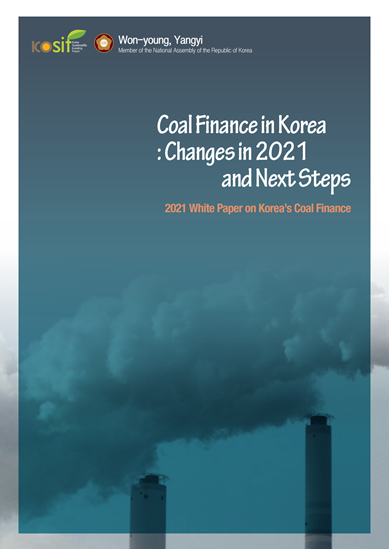|

|
|
Contents
|
|
Executive Summary
Coal Finance in Korea: Changes in 2021 and Next Steps
Carbon Neutrality and Finance
Financial Institutions’ Risks of Coal Assets
Carbon Neutrality of Finance and 2030 Roadmap
Coal Finance Trends in Korea
Coal Finance Ranks in Korea
Attachments
1. Survey and Analysis Methodology
2. Coal Finance by Public Financial Institutions
3. Coal Finance by Private Financial Institutions
4. Carbon Neutrality Goals and Renewable Energy Investments
5. Membership in Carbon Neutrality and Climate Finance Initiatives
|
|
Report Summary
|
|
Declare Coal Phase-Out and Set Carbon Neutrality Goals
|
- Number of institutions that have pledged not to underwrite any more project finance deals for coal-fired power generation and stop investing in coal-related bonds: 100 (at June 2020: 18)
- Number of institutions with plans to withdraw their assets related to coal-fired power generation: 4(Samsung Fire & Marine Insurance, DB Insurance, AIA Life Insurance, Hi Investment & Securities)
- No. of financial institutions that have set carbon neutrality goals: 14 (public sector: 2/ private sector: 12)
- No. of financial institutions with carbon neutrality goals including financed emissions2: 8 (public sector: 0 /private sector: 8)
- No. of financial institutions with plans to achieve carbon neutrality goals: 21
Financial Institutions’ Coal Asset Risks – Exposure to Coal Assets
- Public sector: KRW 39.9 trillion. Korea Development Bank (KDB) with an exposure of approximately KRW 17 trillion to secure control of KEPCO represents 45% of the total.
- Private sector: KRW 46 trillion (Non-life insurance KRW 25.9 tril, life insurance: KRW 14.3 tril, banks: KRW 5 tril)
- 2030 exposures total KRW 34.6 trillion, higher than KRW 33 trillion for 2021 and the exposures are expected to remain high at KRW 28 trillion in 2040.
Financial Institutions’ Carbon Neutrality Goals are Meaningless without a 2030 Roadmap
- Coal-related financed emissions of 44,230,000tCO2e in 2021. The emissions are forecast to remain at 30,000,000tCO2e or higher until 2040 before they start to decrease at a fast rate.
- Considering the maturities of financial assets and other factors, they will likely reach 2050 carbon neutrality goals even if they continue to invest in fossil fuels until 2030.
- Financial institutions are required to form their 2030 roadmap to make sure their carbon neutrality goals entail no greenwashing issues.
- IMF has recommended that the average global greenhouse gas price should be increased up to USD 75 by 2030 in order to achieve carbon neutrality.
- Under the NGFS’ 2050 carbon neutrality scenario, carbon price in Korea is expected to be KRW 160,000 in 2030, KRW 300,000 in 2040, and KRW 820,000 in 2050.
- The cumulative carbon cost of PF, corporate bonds, and other financial projects underwritten by Korean financial institutions is estimated at KRW 190 trillion by 2050 and KRW 150 trillion of this is expected to be generated in 2030 or later.
|
|
Research and Analysis Method
▶ Survey Target: all public and private financial institutions in Korea
▶ Survey Method:
- Public sector: The survey was distributed from the office of National Assembly Member Won-young Yangyi to the competent government ministries and agencies to which the public financial institutions report.
- Private sector: Data was requested to the Financial Supervisory Service (FSS) via the Office of National Assembly Member Won-young Yanyi, and the FSS distributed the survey to individual financial companies.
▶ Time Period: 2009 – 2021 June
▶ Request Data: coal-fired generation-related PF, corporate loans, corporate bonds
▶ Survey Response Agency: Total of 64 Financial Institutions
▶ Analysis: The analysis in this report used PF loans, corporate bonds, and insurance amounts that are related to coal-fired generation from 2009 to the end of June 2021 as the base data.
문의: 김태한 수석연구원 (thkim@kosif.org)
|
|